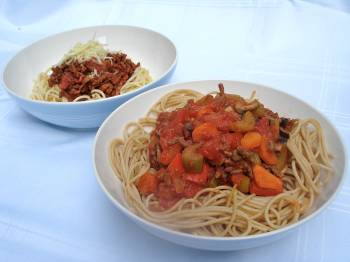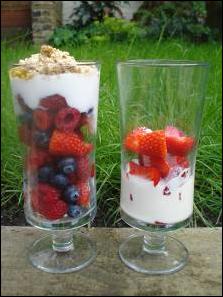

London: Eat more to loose weight, is the latest advice from experts at the British Nutrition Foundation(BNF).
IIn a new leaflet entitled Eat more, lose weight the BNF shows how slimmers can eat enough food to feel really full without consuming too many calories. The advice provided by the BNF is based on scientific evidence that lowering the energy density, or the amount of calories per gram of food consumed, can help people lose weight without feeling hungry1.
By manipulating the energy density of the diet, you can eat much more food for fewer calories, says Bridget Benelam, Senior Nutrition Scientist at the BNF.
“For example, a home-made burger, fried chips, ketchup and a standard soft drink can provide over 1000 calories and weighs about 650g. Whereas, you can eat nearly double the amount in weight (about 1200g) for about half the calories, with a low energy density meal of, for example, soup, a low-fat sandwich, a diet soft drink and a fruit and yogurt dessert.
What is energy density?
Energy density is the number of calories per gram of food (kcal/g). It is mainly affected by the water content, but also by the fat content of the foods.
Foods with a lower energy density include those with a high water content, such as soups and stews, foods like pasta and rice that absorb water during cooking, and foods that are naturally high in water, such as fruit and vegetables. At the other end of the scale, higher energy density foods tend to include those that are high in fat and have a low water content, for example biscuits and confectionery, fried snacks, nuts and full-fat hard cheese2.
The energy density of the diet overall is determined by the balance of higher and lower energy density foods consumed. Small amounts of food with a high energy density can be eaten as part of a low energy density diet, as long as some food with a medium energy density and plenty of food with a low energy density is consumed alongside. Also, by eating foods with a low energy density first, for example, having a salad without oily dressing or a broth-based soup, youll naturally feel fuller and less tempted by the high energy dense foods3, 4.
Menu makeovers
The Eat more, lose weight leaflet shows how simple changes to your daily meals can make a significant difference to the amount of food you can consume for the same number of calories. For example, choosing fruit and cereal, instead of pastries for breakfast, soup and salad instead of burger and chips for lunch, and making a wholemeal pasta dish with a low-fat cheese sauce and extra vegetables, instead of white pasta with a standard full-fat cheese sauce for dinner, means that instead of consuming 2285 calories in 1487g of food, you can have 2321g of food for 1495 calories.
And it doesnt mean completely changing your eating habits favourite recipes also get a makeover in the BNF leaflet. A 400g portion of spaghetti Bolognese with standard mince, bacon and full-fat cheese contains 760 calories. However, a few simple changes can cut its calorie content by well over half. Using lean mince instead of standard mince, choosing wholemeal spaghetti, adding plenty of vegetables and using a smaller portion of a reduced-fat cheese brings the calorie content of a 400g portion down to 330 calories.
Avoiding weight-loss pitfalls
The leaflet also addresses key behaviours that can make or break attempts at weight loss. Benelam continues Its important to remember that we live in an obesogenic* environment and that we need to consider other aspects of our lifestyle, as well as the foods we eat. Things like keeping active, avoiding distractions while eating and resisting the temptation to try every dish at a buffet can really help keep weight control on track.
*Factors tending to make people overweight
1Benelam (2009) Satiation, satiety and their effects on eating behaviour. Nutrition Bulletin 34(2) 126-173
2 BNFs feed yourself fuller chart provides examples of foods with a high medium and low energy density. Find here at
3 Flood JE & Rolls BJ (2007) Soup preloads in a variety of forms reduce meal energy intake. Appetite 49(3) 626-34
4 Rolls BJ, Roe LS & Meengs JS (2004) Salad and satiety: Energy density and portion size of a first-course salad affect energy intake at lunch. Journal of the American Dietetic Association 104 (10) 1570-1576
Low energy density recipe
Spaghetti Bolognese**
Serves 6
The picture below shows the low energy density recipe on the right, and a higher energy density version on the left. Although the low energy density version is nearly double the weight of the higher energy density dish, they contain the same amount of calories.
**Recipe provided by Slimming World
Ingredients
Low calorie cooking spray
1 onion, finely chopped
1 medium carrot, finely diced
2 celery sticks, finely diced
1 red pepper and 1 yellow pepper, deseeded and finely chopped
200g/7 oz button mushrooms,thinly sliced
2 garlic cloves, finely chopped
1 red chilli, deseeded and thinly sliced
1 tsp dried oregano
400g/1lb extra lean minced beef
A handful of fresh basil leaves
2 x 400g can chopped tomatoes
1 tsp artificial sweetener
Salt and freshly ground black pepper
380g/13½ oz dried wholewheat spaghetti
grated reduced-fat Cheddar cheese, to garnish (optional)
Method
1. Spray a large, non-stick pan with low calorie cooking spray and cook the vegetables, garlic,red chilli and oregano for 4-5 minutes. Add the minced beef and fry for a further 3-4 minutes.
2. Reserving a few leaves for garnish, finely chop the basil. Add to the pan along with the chopped tomatoes and sweetener. Season well, bring to the boil, reduce the heat and simmer for 12-15 minutes. Meanwhile, cook the spaghetti according to the packet instructions, drain and keep warm.
3. Remove the sauce from the heat, divide the spaghetti between four warmed plates, and spoon the sauce over. Garnish with the remaining basil and the grated cheese, if using, and serve immediately.
Calories per serving: 330 kcal Energy density: 0.75 kcal/g
Mixed berries, yogurt, granola, honey
Below is the mixed berries yoghurt and honey recipe, compared with a portion of strawberries and cream. Although the portion sizes are clearly different these two dishes contain the same number of calories.
Serves 1
Ingredients
100g low-fat yogurt
1 tablespoon granola
5 fresh strawberries (60g)
15 fresh raspberries (60g)
50g fresh blueberries
1 teaspoon honey
Method
1. Rinse the strawberries, raspberries and blueberries.
2. Place in a bowl or tall glass and cover with the low fat yogurt.
3. Sprinkle the granola on top and drizzle with honey.
Calories per serving: 215 kcal Energy density: 0.7 kcal/g
The leaflet Eat more, weigh less is published by the BNF and available on the BNF website at Leaflet This leaflet is based on research in the area of satiety and appetite control, published by the Foundation
BNF was established over 40 years ago and exists to deliver authoritative, evidence-based information on food and nutrition in the context of health and lifestyle. The Foundations work is conducted and communicated through a unique blend of nutrition science, education and media activities. BNFs strong governance is broad-based but weighted towards the academic community. BNF is a registered charity that attracts funding from a variety of sources, including contracts with the European Commission, national government departments and agencies; food producers and manufacturers, retailers and food service companies; grant providing bodies, trusts and other charities.
The Foundation thanks Slimming World for their advice and help on the content and design of this leaflet.
The British Nutrition Foundation is a registered charity. It promotes the wellbeing of society through the impartial interpretation and effective dissemination of scientifically based knowledge and advice on the relationship between diet, physical activity and health.
